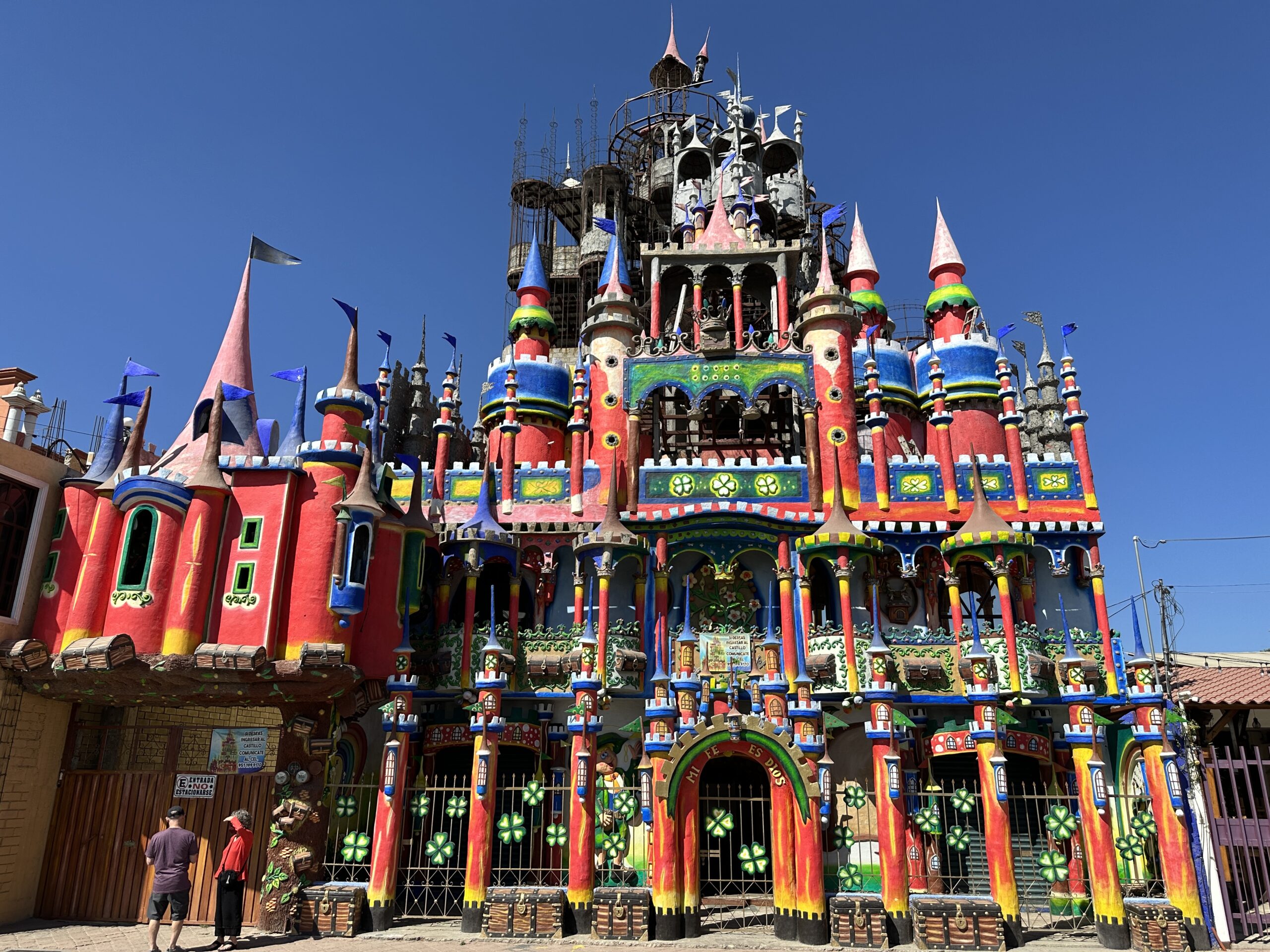El Castillo de Los Duendes

This is going to be a text-light, picture-heavy post. For two reasons.
First, there is shockingly little factual information about El Castillo available. How a castle built on a major street in a town just 30 minutes from Oaxaca can be shrouded in mystery is… a mystery. It didn’t just appear. Maybe no one who’s written about it wants to spoil the effect with facts, and I can respect that. But the lack of information is kind of shocking.
Second, words can’t truly do justice to the experience. It’s like if Henry Darger had been a general contractor and you could tour the results. Or what the dictionary would have as a definition of WTF. Like our experience at Hierve de Agua the previous day, it was clear, standing inside El Castillo, that we were in one of the world’s genuinely unique sites.
Even getting in was special. The gate was padlocked, and there was a sign with the number to call for entrance. We called, and someone came right out to let us in and then lock back up. So we had the place to ourselves and a one-on-one docent. At 50 pesos each to get in (about $2.50), we most certainly got our money’s worth.
It’s hard to know where to start, because there is just so much weird at work. First off, the primary translation of duende is goblin, but duende can also be translated as leprechaun, which is clearly correct. If nothing else, the repeating Pots Of Gold motif is a dead giveaway. But they’re leprechauns with a pretty specific and unambiguous Keebler elf look. There is no mention of this anywhere online. Literally no one who’s written about El Castillo has pointed out that its inhabitants are Keebler elf knockoffs. Mindboggling.


Dorothy suggested that maybe El Castillo came first, and the Keebler elves were based on the El Castillo leprechauns, but I don’t think so. The Keebler elves debuted in 1968, and while there’s no official date of construction that I can find, our docent said El Castillo was 50 years old. So, elves before leprechauns. As the prophecy foretold…
Then there’s the whole psychosexual drama with the leprechauns and the fairies. And the pig and the gnome. Oh, sweet Jesus, the pig and the gnome. Truly, words are inadequate to the task. Let’s just take a look.
Outside
The Prince & Princess
Here’s the meat of the backstory for Il Castillo. There’s Prince Hilario and his one true love, Princess Juanita. Truthfully that’s all we were able to take away. But somehow the entire installation orbits around the two of them and their struggle. Which is real. I guess.
Inside
Mushrooms Everwhere
Sexy Leprechauns & Fairies
These images speak for themselves. Because no one else will.
Yo Soy… GADU?
The first banners seem to say “I am a Mason.” The second banner says GADU, with another Masonic symbol. GADU stands for “Gran arquitecta del universo,” which is the Spanish translation of the Masonic conception of god, the Great Architect of the Universe. So the builder was both a wack job and a Mason. I’m sure the two halves of that Venn diagram barely touch.
The Banquet Hall
There is a banquet hall, because of course there is. I want to get married again, just to be able to rent the hall. I’d invite you all, of course.
Under Construction
There are still a few spots that were framed out for the concrete pour and never completed. Obviously left behind whenever the mothership came back to pick up the builder. But they’re an interesting view of the process.



























































can i live there. nothing fancy. tent in the banquet hall?
You bet. We can be neighbors.
Just like Gaudi’s church in Barcelona? Yes, just like.
Some pig.
And who’s the tramp just below and to the right of Hilario? So many questions.
And absolutely zero answers. We’re left with just making shit up. Which seems, somehow, appropriate.
Mushroom mania to the nth degree…thanks for the trip!!
You just have to believe that those weren’t the only mushrooms involved in the construction.